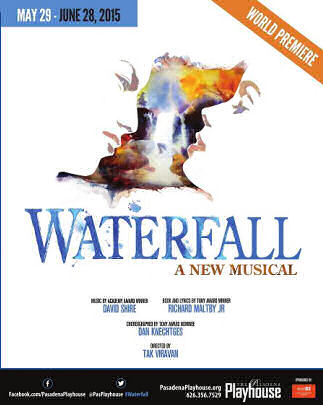
 Did you ever look at a painting, and wonder about the story behind the painting? That was the question that Kulap Saipradit asked in his novel “Behind the Painting“, a story that is required reading in Thailand (from what I have seen on the Internet). It was subsequently adapted into two Thai movies (1985 and 2001), and supposedly into a musical in Thailand (Khang Lang Parp). Richard Maltby. Jr. (Book and Lyrics) and David Shire (Music) have adapted this classic Thai story into a new musical, Waterfall, at the Pasadena Playhouse (FB) (which we saw in a preview performance on Sunday night (May 31, 2015)). According to the program, the ultimate plans are for this musical to continue on to Broadway; it was in New York in early 2014 for a lab development reading. PS: The Jewish Journal has a great article on how this show came to America.
Did you ever look at a painting, and wonder about the story behind the painting? That was the question that Kulap Saipradit asked in his novel “Behind the Painting“, a story that is required reading in Thailand (from what I have seen on the Internet). It was subsequently adapted into two Thai movies (1985 and 2001), and supposedly into a musical in Thailand (Khang Lang Parp). Richard Maltby. Jr. (Book and Lyrics) and David Shire (Music) have adapted this classic Thai story into a new musical, Waterfall, at the Pasadena Playhouse (FB) (which we saw in a preview performance on Sunday night (May 31, 2015)). According to the program, the ultimate plans are for this musical to continue on to Broadway; it was in New York in early 2014 for a lab development reading. PS: The Jewish Journal has a great article on how this show came to America.
The original Thai story dealt with two Thai aristocrats in 1930s Japan and Thailand, who wrestle with their love for each other, and their duty to their family. The two protagonists are both involved in arranged relationships which they entered into out of duty to family and social class. Maltby and Shire’s adaptation keeps the basic elements of the story, but tweaks the story for American audiences to have a young Thai student fall in love with the young American wife of a senior Thai diplomat. This occurs at the time when Siam was transitioning into Thailand, and becoming a democracy (which, alas, didn’t last). The senior Thai diplomat, who had been about to retire, was enticed to stay by an assignment as an envoy to America (where he married his wife). He was then presented with an opportunity he couldn’t pass up: negotiating an alliance between Siam/Thailand and Japan, in the years just before World War II.
In Maltby’s adaptation (I can’t speak to the original), there are two distinct threads: a political threat and a romantic threat; these two threads are tightly interwoven. The political thread I just mentioned; it primarily concerns Noppon, a young Thai student who starts out idolizing America; the older Siamese diplomatic envoy, Cho Khun Atikarn; and his younger wife, Katherine Briggs Atikarn. Noppon, upon graduation from Thai educational system, has been awarded a scholarship to study politics at a prestigious school in Japan. At the same time, Atikarn has been directed by the Siamese government to negotiate the first ever alliance treaty with Japan. Atikarn arrives in Japan, and Noppon is requested (because he speaks English) to escort Katherine during her visit to Japan. More on that later. The political negotiations start to get testy as Foreign Minister Takamota becomes increasingly anti-American, and Japan starts to exhibit its expansionist side. This creates difficulty in the negotiations; the negotiation break off completely when Atikarn is recalled to Siam to help stabilize the government.
Parallel to this story is the story of Noppon and Katherine. This is the big romantic story that is at the heart of the musical (and, indeed, the Thai variations of it have been at the heart of all productions based on the novel). Noppon, upon seeing Katherine, starts to fall in love. Katherine enjoys the attentions of a younger man, and continues to flirt with him as Atikarn’s work brings them to Kyoto. Noppon and Katherine see the sights in the city: the Tanabata Festival, the Taiko Display. Eventually, they take a tour to Mt. Mitake. There, in front of the waterfall, they dance (mmmm, and a little bit more).
This is where Act I ends. In Act II, we see Katherine and Atikarn leave abruptly for Siam, with Noppon left behind to be groomed for the diplomatic corps. He is head over heals with infatuation, and the sudden departure fractures him and forces him into his work. Katherine, on the other hand, is pragmatic. Flings are flings, and her duty is to her husband, the Ambassador. Noppon’s infatuation leads him to send a set of paints to Katherine, as she had mentioned she had painted when she was young. A few years later, Noppon is posted back to Thailand — and we get the reunion. It it what you might predict, or something else? I’ll leave the story there so as not to completely spoil it.
This brings us to where we started: a painting. Going back to the opening of the musical, we see this painting being hung in a new house by Noppon. His wife comes by and says she doesn’t see what Noppon sees in the painting, which is a watercolor of the waterfall at Mr. Mitaki. In particular, she doesn’t understand why the title refers to dancers, when there are none in the picture. This is where Noppon smiles, indicates that he sees the dancers, and starts to relate to the audience the story above.
When dealing with a new musical — and the first big staging of a new musical — a number of areas require analysis: the book, the libretto, the performances, and the technical aspects of the presentation. I’ve described the story above; here are my thoughts on the book:
First and foremost, my mind kept contrasting this to The King and I. There are some parallels. The King and I takes place in the 1860s in Siam — less than 100 years before this story. In The King and I, we see some of the first stirrings of modern thinking struggling against Thai tradition. It is in these areas that Anna clashes with the King, but the King holds fast — it is his son that starts to bring in change. In Waterfall, we have a similar theme being echoed: Noppon (representing Siam’s youth) wants to be all things American. This clashes with Japan, which in the ramp up to WWII was rejecting the modernities of America in favor of the preservation of Japanese culture. When Katherine enters the picture, we begin to see the clash of American attitudes with Thai culture and traditions. We see this first in the reactions of Katherine’s servant, Nuan, to American outspokeness — and we see how Katherine wants to be more Thai. This, in turn, moves Noppon to place greater value in Thai culture… which then clashes with the new Thailand values, which wants to discard Thai culture in favor of the modern world and its Western approaches. This, then, is the culmination of the effort begun with the King’s son in The King and I.
I found the political side of the story fascinating (and I find myself seeing echoes of Pacific Overtures). I have never given much thought to the other countries in East Asia during WWII: were they on the side of Allies, or allied with the Axis? Here we see how Japan was growing ready for WWII, and had significant territorial ambitions. We also see how Thailand tried to straddle the middle (at least according to Noppon); it is unclear how what was presented near the epilogue jives with the truth.
This brings us to the romantic story. My wife found it mostly predictable. I didn’t. I thought it was going to go a particular direction (which the first act makes you want to happen), but then you see how a change in the characters changes that direction, and brings the romantic story to a different, but equally touching conclusions. However, I’m unsure how well this romantic story will play on the Broadway stage. It is certainly more interesting than Light in the Piazza, but given the current nature of Broadway I’m not sure that a romantic story would have a long run. This could be one of a string of Pasadena Playhouse musicals that make it to Broadway, only to have their runs fizzle out. The track record speaks for itself: Baby Its You, Sister Act, A Night with Janis Joplin. I still think they should have brought the excellent Mask to Broadway.
But overall, I liked the book. It wasn’t the immediate grab of a Hairspray or The Book of Mormon, but it wasn’t a failure either.
Next, let’s look at the liberetto — the music and lyrics. I tend to like Maltby / Shire musicals — Baby has a wonderful score, and despite it’s problems there are some great songs in Big. Maltby and Shire also know how to write great story and romantic songs — just look at the revue Closer than Ever. The score for Waterfall is one of the most integrated scores I’ve seen from the team. There are a number of songs I liked as I heard them (alas, it is hard to remember them afterwards — I’d need a cast album). They also had songs that were primarily sung in other languages, both Japanese and Thai. I cannot speak to how well they preserved or captured traditional Thai or Japanese musical stylings. But the songs were beautiful, and well executed by the performers. One thing I did notice was that there were just a few musical motifs; they kept being repurposed for similar songs with similar themes (this is best illustrated by the series of “I Am” songs: “I Am Not Thai”, “I Will Be Thai”; or the “I Like” songs: “I Like Americans”, “I Like the Japanese”, “I Hate the Siamese”).
This brings us to the performances. Before I go into the individual performances, I must comment on what this show says about the lack of diversity in the American theatre, and the lack of suitable dramatic vehicles for Asian actors. In reading the credits, the same shows tended to be listed — shows that are (almost stereotypically) Asian: The King and I, Flower Drum Song, Miss Saigon, Pacific Overtures. I think there need to be more shows that provide the opportunity for Asian actors. What East-West Players does is just a start. Of course, things are not helped by the set of Equity actors, which tend to be overwhelmingly of a common hue. This leads to the next casting complaint: Casting directors that seem to think that all Asians look alike. For those who know, there are distinct differences between the various Asian ethnicities, and the Asian casting here was a mix of Thai, Chinese, Japanese, Filipino, and probably some I couldn’t distinguish. I find this demonstrates a commentary on the acting pool: it indicates there are insufficient actors of a particular group to properly staff the show. This is something the theatre community needs to combat: we need to encourage more diversity in the acting pool (and diverse stories to employ them). [This is where 99 seat theatre demonstrates its importance: it is that stepping stone for non-traditional actors to grow in their craft; the large paying productions cannot employ sufficient ethnic actors and tend to create a high bar to entry.]
In the lead positions were Bie Sukrit (FB) as Noppon and Emily Padgett (FB) as Katherine. This was Sukrit’s first appearance on an American stage — he is evidently a pop star in Thailand — and he came across as the equal to the other Equity actors sharing the stage. I initially found his accent required close listening, but as I got used to it there was no problem. He did, however, need greater amplification to equal Padgett and to overpower the orchestra (hopefully, this will be fixed by opening night). As for Padgett — what a lovely voice, almost operatic. It was well suited for the music, and blended well with Sukrit’s lighter voice. Both did a great job of bringing the characters to life in a way that you believed they were who they were, and that they were reflecting the emotions that the story required. I’d try to name particular songs that they excelled at, but they were all great.
In major supporting positions were Thom Sesma (FB) (Chao Khun Atikarn), J. Elaine Marcos (FB) (Nuan), and as Noppon’s college friends, Jordan De Leon (FB) (Santi, Ensemble), Colin Miyamoto (FB) (Surin), and Lisa Helmi Johanson (FB) (Kumiko, Ensemble). Again, all were excellent. I was particularly taken with the presence that Sesma had as Atikarn — he gave off a wonderful diplomatic flair, and had a lovely singing voice. Marcos, as Nuan, captured the culture clash well and was particularly enjoyable in the number “I Will Be Thai”. Lastly, of Noppon’s college friends, I particularly enjoyed Johanson’s Kumiko, who captured well both the joy and angst of being an Asian who was an American in the period before WWII. This came across extremely well in the song “America Will Break Your Hear”, as well as “Music to my Ears”.
Notable smaller supporting characters were Steven Eng (FB) (Foreign Minister Takamoto) and Marcus Choi (FB) (Thai Minister, Japanese Attaché, Ensemble), both who were great in their songs “I Like Americans” and “I Hate the Siamese” (respectively). Eng was particularly menacing in his role; this is a good thing given the nature of the role. Rounding out the cast were: Eymard Cabling (FB) (Siamese Ambassador, Ensemble), Rona Figueroa (FB) (Yamaguchi Sister, Ensemble), Kimberly Immanuel (FB) (Pree, Yamaguchi Sister, Ensemble), Kenway Hon Wai K. Kua (FB) (Taiko Drummer, Ensemble), Leon Le (FB) (Taiko Drummer, Ensemble), Koh Mochizuki (FB) (Taiko Drummer, Ensemble), Celia Mei Rubin (FB) (Ensemble), Darryl Semira (FB) (Ensemble, Dance Captain), Riza Takahashi (FB) (Yamaguchi Sister, Ensemble), Kay Trinidad (FB) (Ensemble), and Minami Yusui (FB) (Ensemble). I’ll note that Figueroa, Immanuel, and Takahashi sounded lovely together in “Music to my Ears”.
As previously noted, the show featured lyrics by Richard Maltby. Jr. and music by David Shire. Music supervision and additional arrangements were by John McDaniel (FB), with orchestrations by Jonathan Tunick (FB). Mark Hartman (FB) was the associate conductor. McDaniel and Hartman conducted the 13 piece orchestra consisting of Christian Regul (FB) [Keyboard 2], David Witham (FB) [Keyboard Swing], Greg Huckins (FB) [Reed 1], Sean Franz (FB) [Reed 2], Bill Wood (FB) [Bassoon], Nathan Campbell [French Horn], Marissa Benedict (FB) [Trumpet], Mark Converse (FB) [Percussion], Trey Henry [Bass], Carrie Holtzman-Little and Jody Rubin [Viola], and Rebecca Merblum (FB) and Stan Sharp [Cello]. The orchestra produced a lovely sound, which was notable for its inclusion of traditional Thai and Japanese instruments, such as the Ranat Ek, a curved, xylophone-like instrument.
Movement was choreographed by Dan Knechtges (FB), assisted by Jessica Hartman (Associate Choreographer). Dance music arrangements were by Greg Jarrett. The movement and dance was visually delightful, especially the numbers that incorporated traditional Thai and Japanese dance movements and motifs. There were also a number of moments of traditional ballroom and modern swing dancing (reflecting 1930s style) that were great. I will note that the kneepads were visible in a number of dance numbers; that could be visually distracting for some. Darryl Semira (FB) was the Dance Captain.
Waterfall was directed by Tak Viravan (FB); Dan Knechtges (FB) was the co-director, and Kenneth Ferrone (FB) was the Associate Director. I’ll note that Viravan, in conjunction with the producer, Jack M. Dalgleish, were the primary drivers on bringing the show to America, and the Dalgleish was the one who reached out to Maltby/Shire to adapt the show for an American audience. I’ve noted before how I have difficulty seeing where the director stops and the actor begins, and so I tend to credit the actor. I’ll credit the director here for the vision that was realized, and for capturing the little things from that culture. This was particularly apparent in the interactions with Nuan, who was very deferential and submission, which made her hesitancy later on speaking up much stronger. Management was provided by the following team: Andrew Neal (FB) [Production Stage Manager], Lucy Kennedy (FB) [Assistant Stage Manager], Heather “Red” Verhoef [Production Manager/Assistant Stage Manager], Joe Witt [General Manager], Kristen Hammack (FB) [Producing Associate / Company Manager].
Lastly, let’s consider the technical side. The Pasadena Playhouse is blessed with a large flyspace, large wings on both sides, and a deep stage. Sasavat (Ja) Busayabandh, the scenic designer made good use of this space for scenic elements that flew down (Christine Peters was the Associate Scenic Designer). However, the main scenic elements were walls with rough jagged edges that slid left and right, seemingly like textured stone walls. Against these walls, projections designed by Caite Havner Kemp [Projection Designer] were used to establish locale. I recently listened to a Producer’s Perspective podcast with director Scott Schwartz where he opined that he didn’t like heavy use of projections; he felt they were a cost-saving crutch and preferred real theatrical designs. Yet these projections worked against the walls; they were particularly noteworthy during the painting scene of the Waterfall where you could see how the watercolors interacted to form the picture. Most of the other scenic elements were a bit simpler; I’ll note that the set piece for the waterfall was notable in its use of real running water on stage that was splashed around (something you rarely see). Overall, the scenic design worked well for the Playhouse space. It also interacted well with Ken Billington‘s lighting design. This design was noteworthy for its used of the color palette, in particular the washes used against the rear cyclorama. The costumes (designed by Wade Laboissonniere) and hair, wigs and makeup (designed by J. Jared Janas) seemed appropriately period; I don’t have the expertise to speak to whether the traditional Japanese and Thai costumes were correct (they appeared correct to my Western eye, but what do I know?). I particularly enjoyed the dresses worn by Katherine (Emily Padgett (FB)) and Kumiko (Lisa Helmi Johanson (FB)), which were both beautiful, flattering to the actors, and fit in the late 30s time period. Lastly, the sound design by Dan Moses Schreier was mostly clear; there were a few microphone static problems that I presume will be corrected by the official opening (this was a particular problem in the waterfall scene). As noted before, Bie needed some additional amplification. Additional design and related credits: Brad Enlow [Technical Director], Stewart/Whitley (FB) [Casting].
According to the main credit page, Waterfall was produced by the Pasadena Playhouse (FB) under the artistic direction of Sheldon Epps, in association with the 5th Avenue Theatre (FB) in Seattle (which will present Waterfall in the fall of 2015). Articles on the show indicate that eventual producers will be the director (Tak Viravan)’s producing business, Scenario Company, in conjunction with Jack M. Dalgleish.
Waterfall continues at the Pasadena Playhouse (FB), formally opening on June 7, 2015 and running until June 28, 2015. If you’re a fan of new musicals, or of Maltby/Shire musicals, or of Asian culture, this is especially well worth seeing. Tickets are available online through the Pasadena Playhouse website. Discount tickets may be available through special Pasadena Playhouse programs, Goldstar, LA Stage Tix, and other common outlets.
One last note regarding Waterfall — in particular, about the Waterfall audience. Sheldon Epps, the Artistic Director of the Playhouse, is well known for pushing diversity on stage. When we were subscribing at the Playhouse, this meant that there were a fair number of African-American themed plays. I always bemoaned the fact that the complexion of the audience would change for those plays; there was a distinct color shift I found disturbing. My disturbance wasn’t due to the black audiences — I want diverse and younger audiences discovering and coming to theatre. My disturbance was more the absence of the typical audience of non-color 🙂 — why were they avoiding the play (I’m similarly disturbed about the fact that the audiences of color don’t come to traditional plays). The same shift was notable in the Waterfall audience — it skewed much more Asian than the typical Playhouse audience. As a result, I must make the comment I always make: Theatre is like music — it is either good or bad. It is not “Asian”, it is not “Black”, it is not “White”. It reflects and comments on situations that are set in a wide variety of communities. Audiences must make an effort to go to a wide variety of theatre that reflects diverse experience, and not only the shows that reflect their particular ethnic experience. This permits theatre to do its job, moving people to learn and think about how people react in various situations. End soapbox.
Ob. Disclaimer: I am not a trained theatre critic; I am, however, a regular theatre audience. I’ve been attending live theatre in Los Angeles since 1972; I’ve been writing up my thoughts on theatre (and the shows I see) since 2004. I do not have theatre training (I’m a computer security specialist), but have learned a lot about theatre over my many years of attending theatre and talking to talented professionals. I pay for all my tickets unless otherwise noted. I believe in telling you about the shows I see to help you form your opinion; it is up to you to determine the weight you give my writeups.
Upcoming Shows: June will be exhausting with the bounty that the Hollywood Fringe Festival (FB) brings (ticketing is now open). June starts with a matinee of the movie Grease at The Colony Theatre (FB), followed by Clybourne Park (HFF) at the Lounge Theatre (FB) Camenot at the Complex Theatres (FB) (Clybourne Park was cancelled) on Saturday, and a trip out to see the Lancaster Jethawks on Sunday. The second weekend of June brings Max and Elsa. No Music. No Children. (HFF) at Theatre Asylum (FB) and Wombat Man (HFF) at Underground Theatre (FB) on Saturday, and Marry Me a Little (HFF) by Good People Theatre (FB) at the Lillian Theatre (FB) on Sunday. The craziness continues into the third weekend of June, with the Nigerian Spam Scam Scam (HFF) at Theatre Asylum (FB) and Merely Players (HFF) at the Lounge Theatre (FB) on Saturday, and Uncle Impossible’s Funtime Variety & Ice Cream Social, (HFF) at the Complex Theatres (FB) on Sunday (and possibly “Matilda” at the Ahmanson Theatre (FB) in the afternoon, depending on Hottix availability, although July 4th weekend is more likely). The Fringe craziness ends with Medium Size Me, (HFF) at the Complex Theatres (FB) on Thursday 6/25 and Might As Well Live: Stories By Dorothy Parker (HFF) at the Complex Theatres (FB) on Saturday. June ends with our annual drum corps show in Riverside on Sunday. July begins with “Murder for Two” at the Geffen Playhouse (FB) on July 3rd, and possibly Matilda. July 11th brings “Jesus Christ Superstar” at REP East (FB). The following weekend brings “Green Grow The Lilacs” at Theatricum Botanicum (FB) [and may also bring The History Boys at the Stella Adler Lab Theatre (FB) (I’m considering it)]. July 25th brings “Lombardi” at the Lonny Chapman Group Rep (FB), with the annual Operaworks show the next day. August starts with “As You Like It” at Theatricum Botanicum (FB), and is followed by the summer Mus-ique show, and “The Fabulous Lipitones” at The Colony Theatre (FB). After that we’ll need a vacation! As always, I’m keeping my eyes open for interesting productions mentioned on sites such as Bitter-Lemons, and Musicals in LA, as well as productions I see on Goldstar, LA Stage Tix, Plays411.
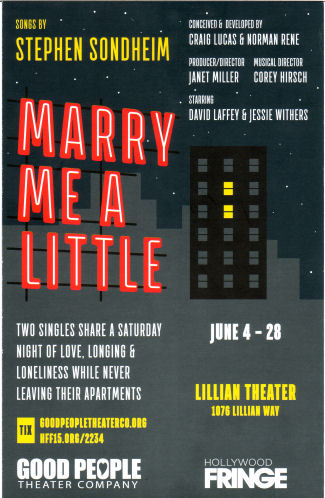
 What’s better on a Sunday afternoon that a little Sondheim?
What’s better on a Sunday afternoon that a little Sondheim?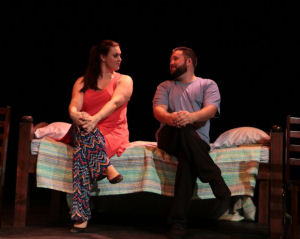 The performances were great, both individually and together. Some general comments before I touch upon the individual actors (who are illustrated in the production still to the right). I particularly enjoyed that GPT did not cast the typical image of a Hollywood actor — thin and chisled and shaped. The actors in this show looked like real people, and that little, subtle touch made the show relatable and believable. This wasn’t an unobtainable couple, this was an everyperson couple. That was great. The two actors had remarkable chemistry together, which was clearly visible in songs like “So Many People” (from Saturday Night), “A Moment With You” (also from Saturday Night), and “Pour Le Sport” (from the unproduced The Last Resorts).
The performances were great, both individually and together. Some general comments before I touch upon the individual actors (who are illustrated in the production still to the right). I particularly enjoyed that GPT did not cast the typical image of a Hollywood actor — thin and chisled and shaped. The actors in this show looked like real people, and that little, subtle touch made the show relatable and believable. This wasn’t an unobtainable couple, this was an everyperson couple. That was great. The two actors had remarkable chemistry together, which was clearly visible in songs like “So Many People” (from Saturday Night), “A Moment With You” (also from Saturday Night), and “Pour Le Sport” (from the unproduced The Last Resorts).

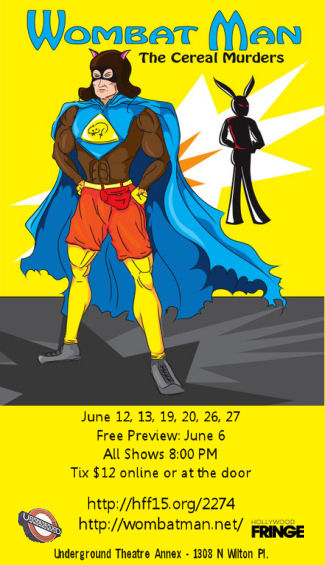





 Did you ever look at a painting, and wonder about the story behind the painting? That was the question that
Did you ever look at a painting, and wonder about the story behind the painting? That was the question that 
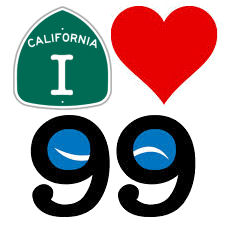 One of the hallmarks of theatre — especially intimate theatre — is its creativity. Whereas at the cinema the director can call on a special effects team to make movie magic through a combination of CGI and effects that look good on film; the theatre director can only call on imagination and creativity, because live theatre by definition is live and in front of you. Perhaps this is one reason we don’t see a lot of plays that take place in outer space. Luckily, we saw one of the few that exists last night, and it was excellent and creative and remarkable and funny and … well, almost any superlative you can think of. Unluckily (at least for you), you won’t be able to see it; this write-up will have to suffice. The show that you missed (but we saw) was
One of the hallmarks of theatre — especially intimate theatre — is its creativity. Whereas at the cinema the director can call on a special effects team to make movie magic through a combination of CGI and effects that look good on film; the theatre director can only call on imagination and creativity, because live theatre by definition is live and in front of you. Perhaps this is one reason we don’t see a lot of plays that take place in outer space. Luckily, we saw one of the few that exists last night, and it was excellent and creative and remarkable and funny and … well, almost any superlative you can think of. Unluckily (at least for you), you won’t be able to see it; this write-up will have to suffice. The show that you missed (but we saw) was 
 Back in February, we saw the Southern California return of a
Back in February, we saw the Southern California return of a 
